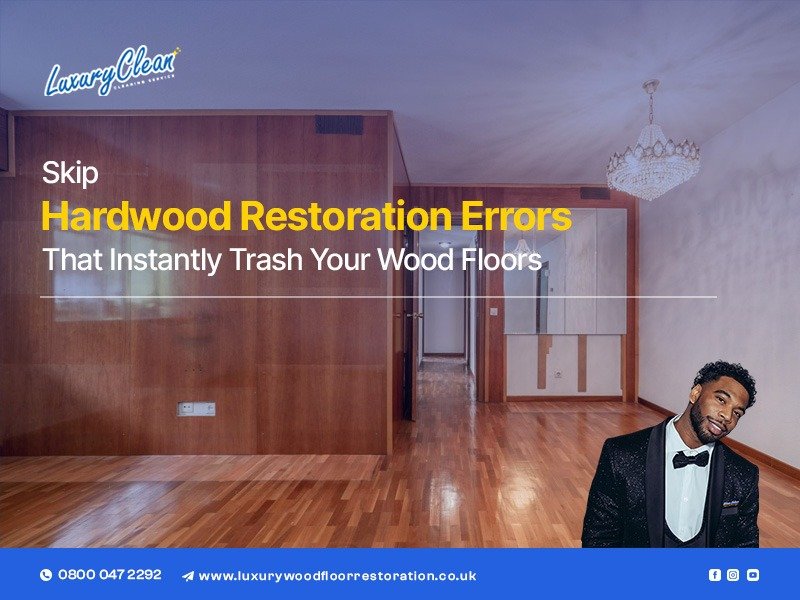If your hardwood floors look tired, restoration might seem like a quick win. But here’s the kicker: even one mistake can wreck your finish, destroy your boards, or cost you thousands. Hardwood restoration sounds simple, but it’s riddled with tripwires most DIYers (and even some pros) miss. To avoid ruining your floors during hardwood restoration, skip common errors like skipping prep, using the wrong grit, over-sanding edges, or applying finish too soon. Always test, clean thoroughly, and follow curing times. Proper technique and timing are non-negotiable.
The Prep Step Most People Rush, and Regret Later
Most damage in hardwood restoration happens before the sander ever touches the floor. The prep phase feels boring until skipping it ruins everything.
Miss this, and you’ll grind dirt into the wood instead of sanding it off. The result? A cloudy finish, uneven tone, and blotchy spots that won’t go away.
- Skipping a deep clean ruins adhesion: Dust, oils, and residues sabotage stain and finish bonding.
- Forgetting to fix squeaks and loose boards? Big mistake: Vibrations during sanding worsen the problem.
- Ignoring moisture readings causes cupping or cracking: Wood expands and contracts. Get it wrong and it’ll warp.
- Using furniture sliders instead of lifting: You’ll scratch or compress fibres, making the damage permanent.
Grit Matters: The Wrong Sequence Wrecks Results
Sanding is not just about smoothing, it’s about structure. Using the wrong grit order will destroy your floor’s surface, not restore it. Every grit you skip compounds the damage of the last. Think of it like shaving with a butter knife, then switching to a razor. Doesn’t fix the butcher job, just bleeds more.
- Starting too coarse creates deep gouges: You’ll spend hours trying to fix them, and might not succeed.
- Skipping grits leaves swirl marks: Each grit removes the scratches from the one before. Miss a step? They’re permanent.
- Going too fine before staining blocks absorption: Your stain will look weak, patchy, or downright fake.
- Using edge sanders improperly leaves visible rings: Especially near baseboards where light hits hardest.
Finish Fails: Rushing Application and Skipping Cures
Applying the finish seems like the easy bit. But it’s also where most jobs go off the rails. Hardwood refinishing isn’t done when the finish dries; it’s done when it cures. Cure time ≠ and dry time. Confuse the two, and you’ll trap failure into every step you walk on.
- Applying finish in humid conditions slows curing: That sticky feel? It’s not temporary, it’s trapped moisture.
- Walking on floors before the full cure causes dents: Even socks can leave marks. Your dog? A disaster.
- Mixing incompatible stains and finishes creates peeling: Know your formulas. Oil + water isn’t just a metaphor.
- Skipping a final buff means rough texture: Even if it looks good, it’ll feel gritty and cheap.
The Moisture Misstep: Climate-Control Chaos
Restoration doesn’t happen in a vacuum, especially not in homes with fluctuating humidity. Whether you’re in Yorkshire or Bristol, UK homes are famously unpredictable in temperature and dampness. Moisture control isn’t optional; it’s the backbone of floor integrity.
- Restoring too soon after leaks causes mould growth: Even hidden moisture under boards can rot them from within.
- Skipping acclimation leads to gapping: Wood needs to match the room humidity before sanding begins.
- Not running a dehumidifier? Expect buckling: Especially in summer months with open windows.
- Applying finish in the wrong temperature range weakens the bond: That fancy topcoat? It won’t stick properly.
Bad Gear, Worse Technique: Equipment Errors That Cost You
A perfect plan means nothing if your tools betray you. Most DIYers don’t rent pro-grade gear, or they misuse what they get. That’s when floor damage gets expensive. Sanding machines are not forgiving. They do exactly what you tell them, whether that’s right or wrong.
- Using outdated sanders causes chatter marks: Those wave patterns? Almost impossible to fix.
- Holding the drum in one place = instant gouge: A one-second pause can destroy a plank.
- Underpowered vacuums leave airborne dust: Your finish will trap it in place forever.
- Skipping edge sanding tools leaves shadow zones: The result? A “halo” around every wall.
- Not testing machines before use is careless: A faulty belt or dull blade can ruin your entire day.
Before you seal that final coat, take a step back. Restoration is more than sanding and staining; it’s about precision. Whether you’re tackling a full hardwood refinishing project or just repairing a patch, getting the steps wrong once can mean starting over.
Conclusion
You don’t need to be an expert; you just need to stop doing what ruins the job. Prep better. Sand smarter. Respect moisture. Use the right tools. And never confuse “dry” with “done.”

